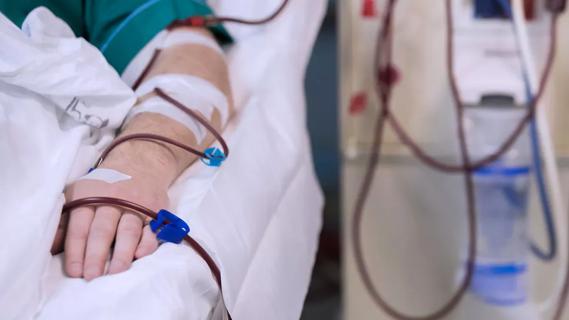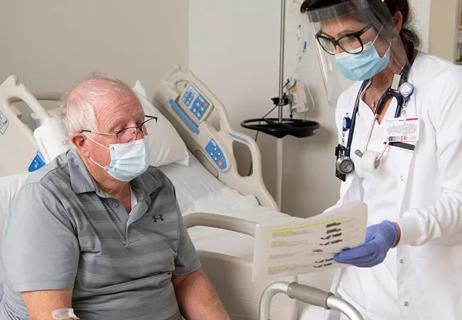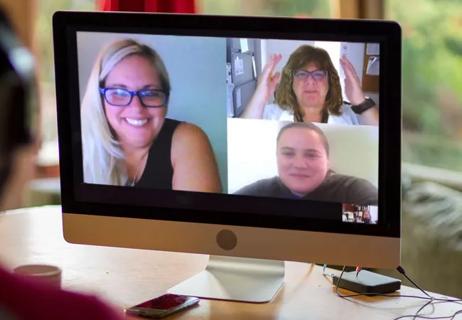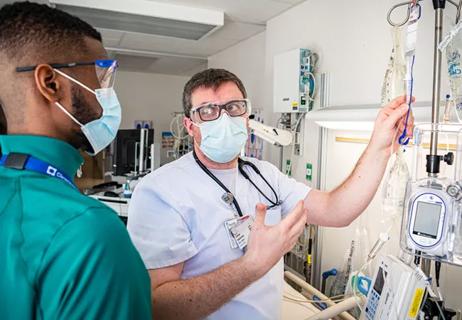Providing 1:1 nursing care in the home setting

Upon discharge from the hospital, many patients recovering from illness or injury are sent home to receive further care and treatment – and registered nurse (RN) case managers have the gratifying role of leading and coordinating this home healing process.
Cleveland Clinic is a non-profit academic medical center. Advertising on our site helps support our mission. We do not endorse non-Cleveland Clinic products or services. Policy
Depending on the patient’s condition, homecare services can range from less than a week to up to 60 days. At Cleveland Clinic’s Center for Connected Care, the average days for homecare service per patient is about 35, although it varies greatly. Patient census for the health system’s three homecare regions – East, West and South – combined is approximately 2,000 adults.
Cleveland Clinic also provides pediatric homecare services to patients who are under the age of 18, although the pediatric patient census is much lower at 100 patients. RN case managers who serve the pediatric population have the same roles and responsibilities as those who serve the adult population; however, they are specially trained and hold certifications in pediatric care. Andrea Owen-Shearer, BSN, RN, COS-C, Nurse Manager for Cleveland Clinic Home Health’s East Region, says RN case managers on her team generally have 20-25 patients to manage at any given time.
The basic guidelines for a patient to receive homecare requires the patient be homebound, meaning it is taxing for them to leave their home. The patient’s discharging physician provides specific orders to the homecare intake department, outlining homecare services the patient will need. These services could range from speech therapy, occupational or physical therapy to infusion therapy or PICC (peripherally inserted central catheter) line management, wound care management, skilled nursing and more.
The intake department accepts the orders, coordinates with the referring physician and hospital, and assigns the patient’s case to an RN case manager who serves the geographic area where the patient lives (assignments are generally categorized per zip code). The RN case manager begins the initial opening process for the case, otherwise known as a ‘start of care.’ From this point forward, the case manager is the caregiver lead on the case – devising treatment plans, coordinating and providing care, delegating visits to LPNs (licensed practical nurses) as needed, educating patients and their families, assessing the home environment and any obstacles to care, overseeing home health aides/STNAs (state tested nursing assistants), and working collaboratively with the patient’s primary care physician, medical specialists, pharmacists, and other caregivers.
“Essentially, case managers harmonize the various services that are being provided by other caregivers to ensure the patient’s needs are met,” says Owen-Shearer.
She explains that for just one patient case, there may be multiple physicians and caregivers involved in the plan of care – requiring exceptional communication and ongoing multi-disciplinary collaboration. For example, if the patient is recovering from a motor vehicle accident, the caregiver team could include a trauma surgeon, physical therapist, primary care physician and others.
“Within one nursing care plan, you may have five individualized plan components so RN case managers must continually retrieve information, report back and collaborate,” she adds.
Communication is primarily conducted through a combination of the Epic EMR (electronic medical record) system, which is used across Cleveland Clinic care areas, including inpatient, outpatient and homecare, and Microsoft® Teams virtual or phone meetings. Each RN case manager carries a laptop and mobile phone, as well as a bag of nursing medical supplies and a trunk stock of everything they may need, which right now, also includes PPE such as face shields and masks due to the COVID-19 pandemic.
In the first ‘start of care’ visit, which is generally a 2-hour visit, the case manager:
“A significant part of home care nursing is setting your patients up for success by building independence and confidence in their abilities to care for themselves,” Owen-Shearer says. “Since we aren’t with patients 24/7, detailed education is very important. It may require a 3-day session or longer of teaching, teaching back and verifying that the patient and/or patient’s family understands all that is needed. We teach them until we are certain they know what needs to be done.”
The number of patient visits is dependent upon each patient’s specific needs. For example, a patient requiring wound care may need to be seen daily or 3-4 times per week for several weeks. A patient with an infection that is being treated primarily with an antibiotic may be seen for two weeks. Or, a patient who is bedbound with a Foley catheter may only be seen once every 30 days.
As the eyes and ears for patients, Owen-Shearer says the care and support provided by RN case managers is centered on ensuring patients have what they need to live and function at the highest level possible.
In addition to traditional nursing care, that support may come in the form of putting in a request for a patient to have handrails installed in their shower or evaluating their medications to verify accuracy, expiration dates, refills, and safety, including cross-referencing medications they may have been taking before they were hospitalized with those prescribed as a result of the hospitalization. They also assess for needs such as social workers, protective services, or community resources like ‘Meals on Wheels’ or food banks. Coordinating patient transportation to and from medical appointments is another major area of support.
Additionally, as home health continues to grow at an accelerated pace, RN case managers are providing more acute care services in the home care setting, often mirroring what is done in hospitals for infusions, complicated wound care, therapy, trach care/teaching, ostomy, pleural drains, labs and more.
“Our end-goal is to help every patient get better and have better outcomes, which are also reported and measured through the OASIS tools,” says Owen-Shearer.
For many RN case managers, this career path is incredibly rewarding – especially because of the opportunity it offers for personalized, one-on-one patient care.
“As a case manager, you have a unique perspective and patient relationship you won’t get in any other form of nursing,” Owen-Shearer says. “You are in the patient’s environment and you see first-hand what brings them pleasure or pain. You also see the progression of the work you are doing, which is simply amazing. The appreciation patients have for us as we work in and out of their homes is beautiful. This is a connection that truly makes a difference.”
Owen-Shearer says when she conducts staff interviews with her team to better gauge what they like or dislike about their jobs, her colleagues agree that what they enjoy most are the unique relationships they have with patients, seeing the outcomes of their work, and feeling the positive impact of what they do.

Phone triage system reduces call backs and delays in care

New protocol reduces costs, increases patient and caregiver satisfaction

New options benefit caregivers, nursing units and patients

Nurses facilitate preoperative program to educate and prepare patients for ongoing care

Introduces at-home work and new patient screening tool

Health disparities, mental health and more

Ideas for approaches to prevention, response and more

Educating and developing generations of nurses